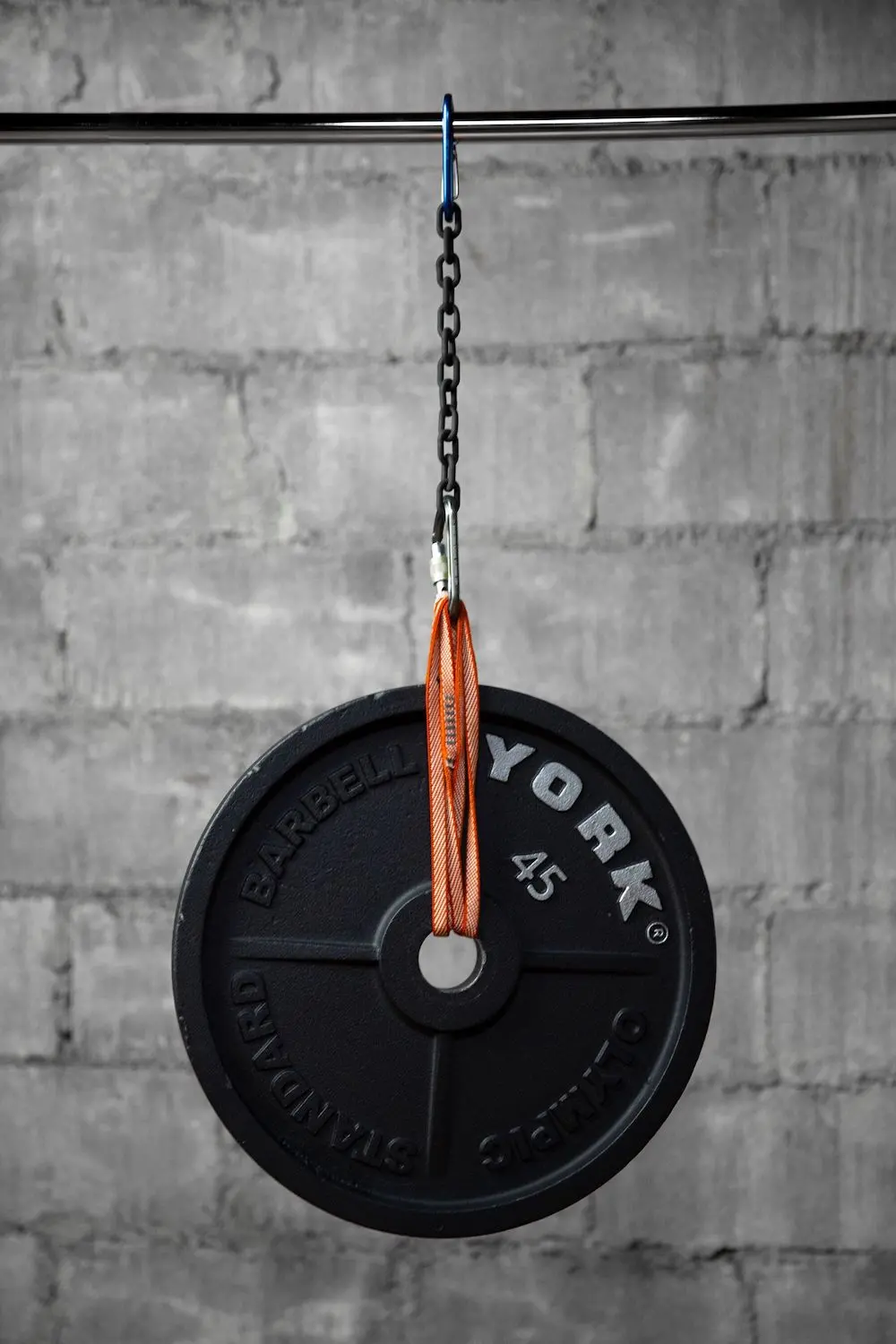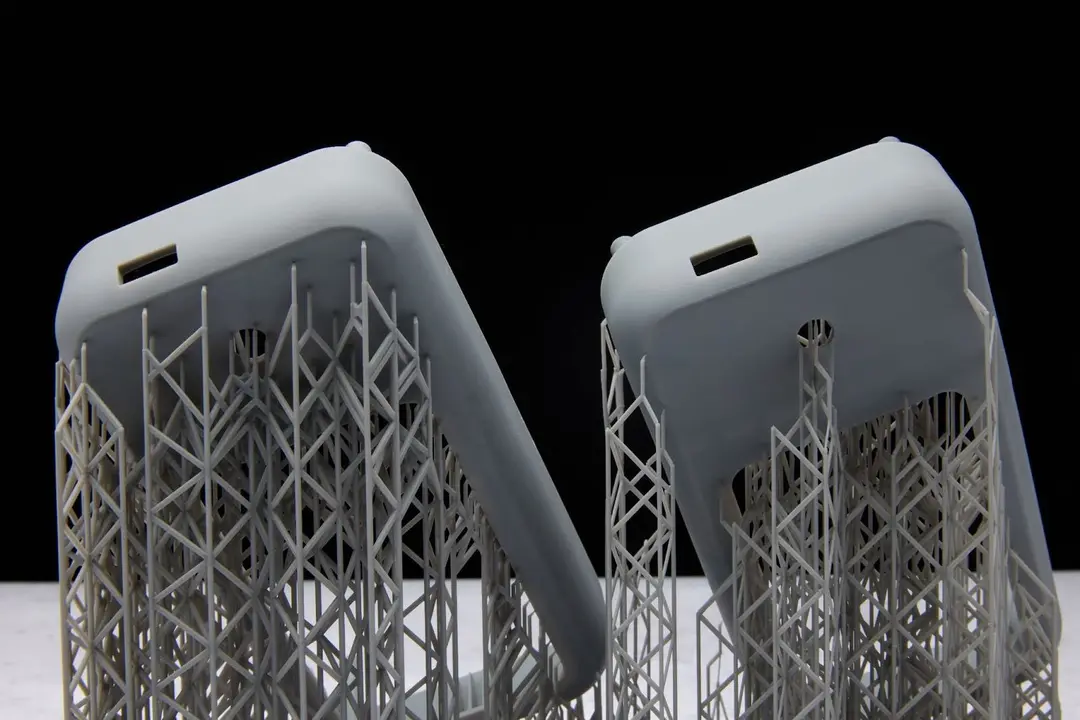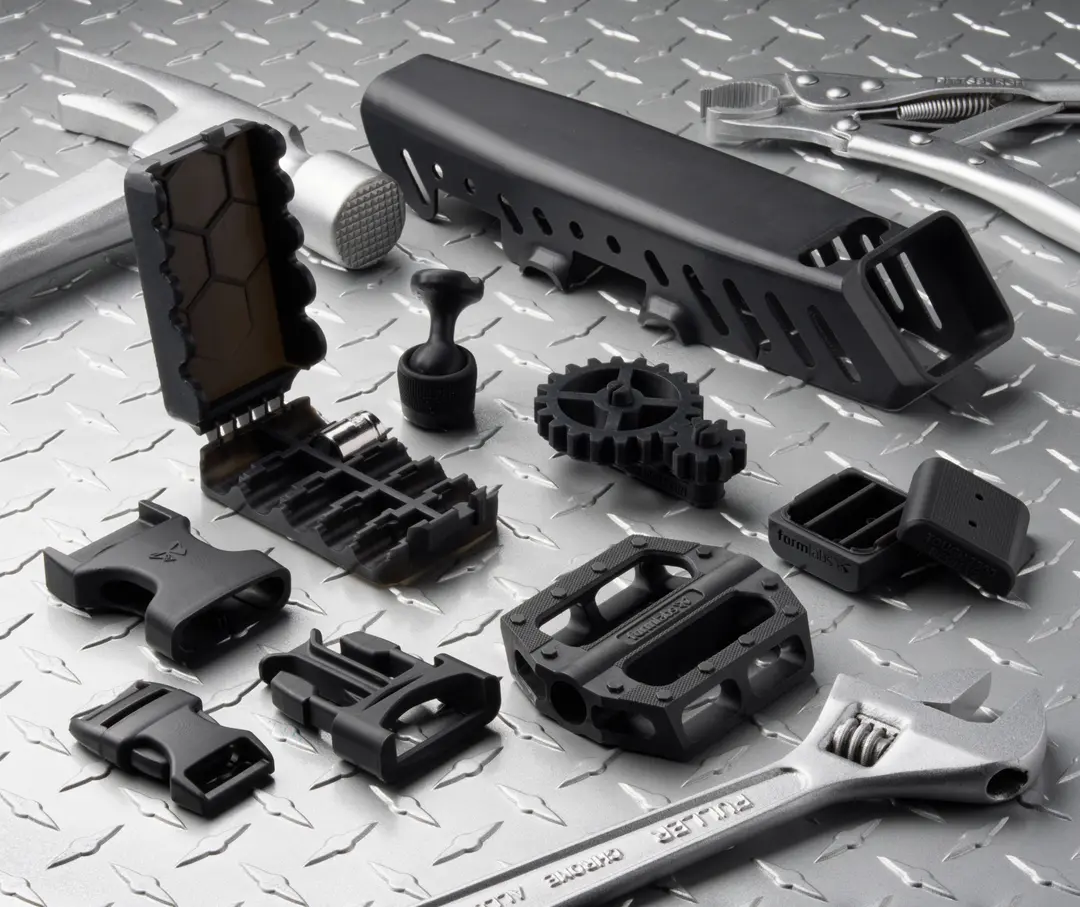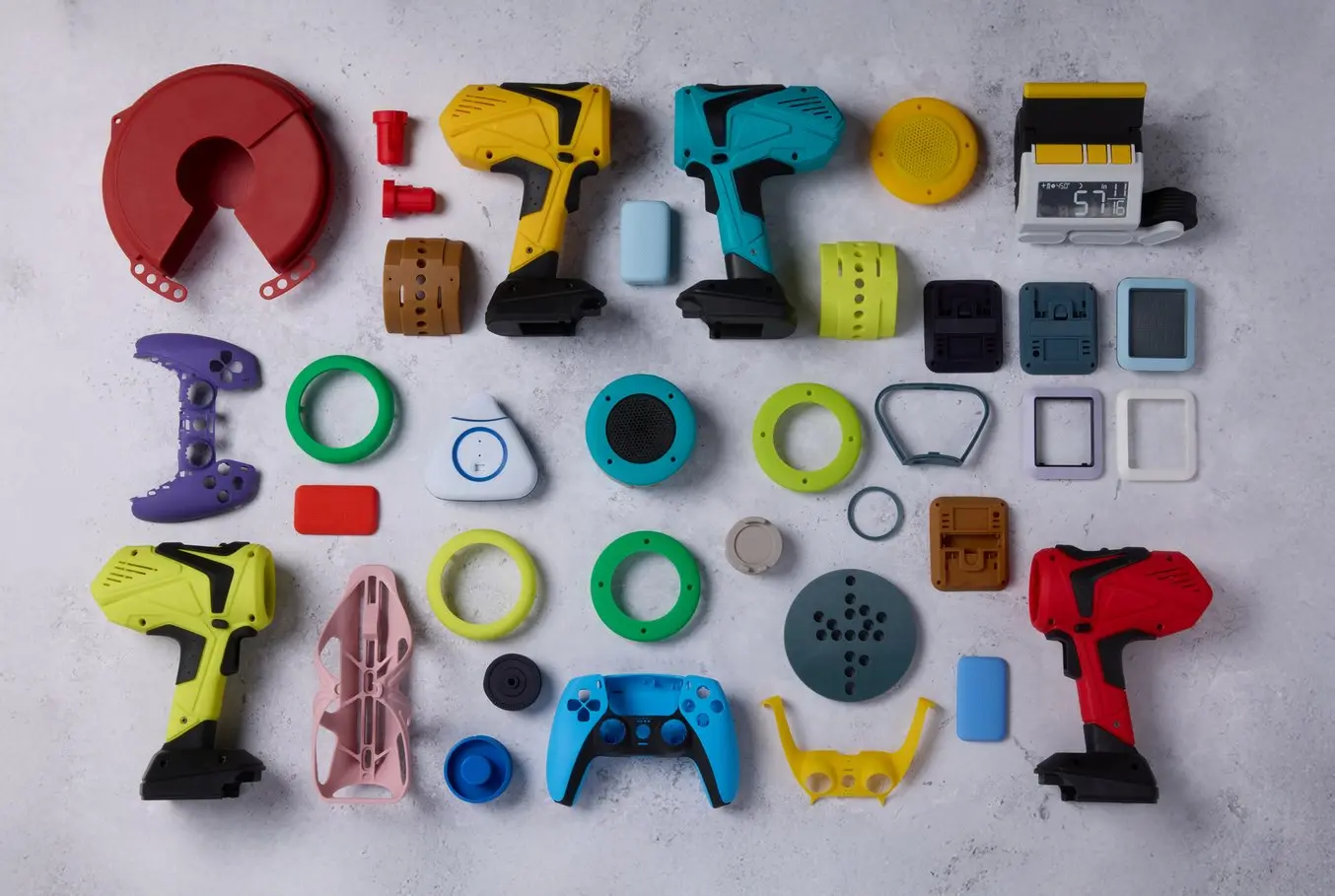
Möchten Sie Teile in kräftigen Farben 3D-drucken oder mehrfarbige Druckteile erstellen? Im Zuge der letzten Jahre haben neue Methoden den Markt erreicht, um farbige 3D-Drucke zu erstellen. Auch sind neuere 3D-Drucker erschwinglicher geworden, sodass jeder seine Kreationen jetzt in einer ganzen Reihe von Farbschattierungen umsetzen kann – ob es sich um technische Bauteile, Modelle oder Hobbyprojekte handelt.
In diesem Leitfaden beleuchten wir verschiedene Techniken, mit denen Sie farbige 3D-Druckteile anfertigen sowie die Technologien und Anwendungen des 3D-Farbdrucks.
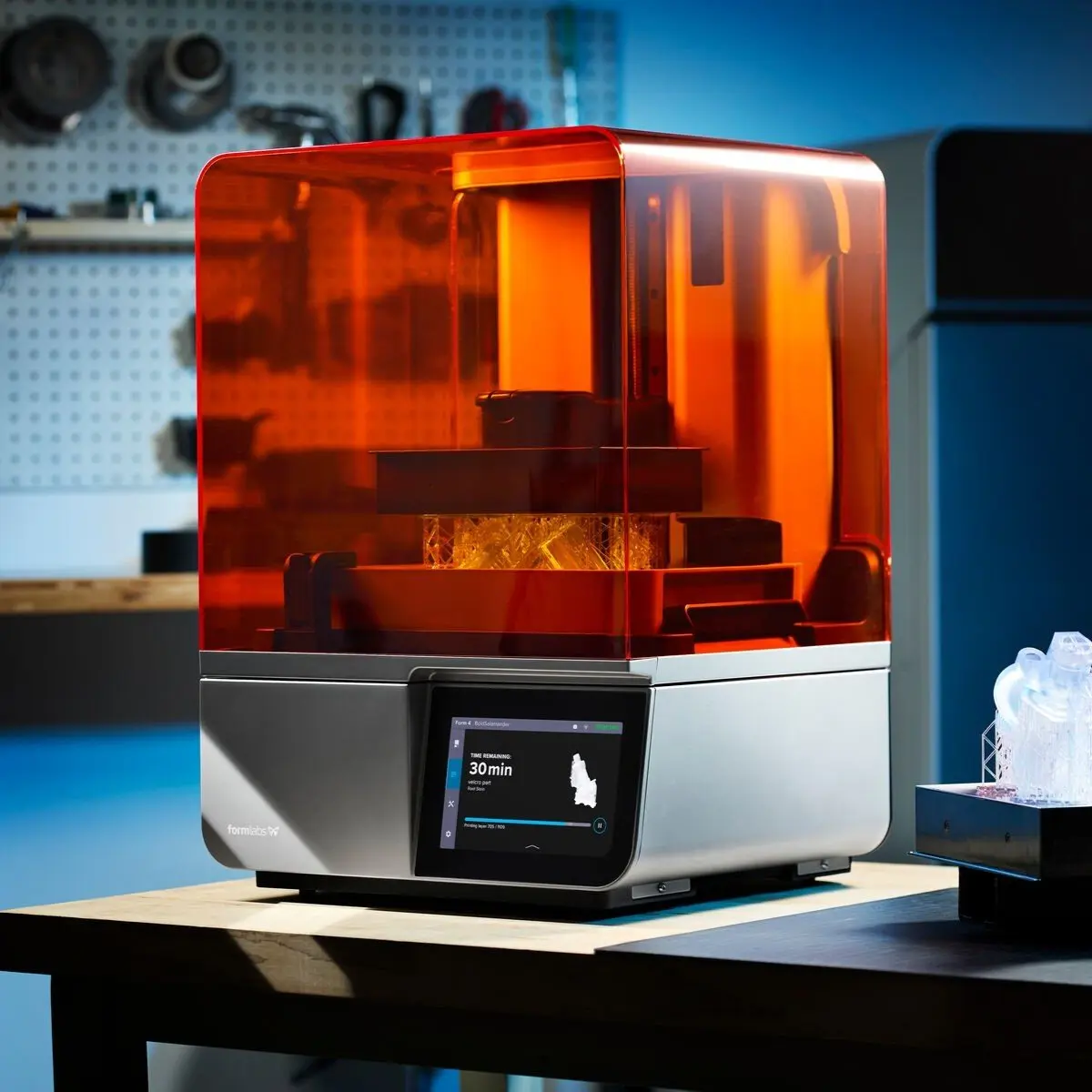
Kostenlose Beratung buchen
Kontaktieren Sie unser Expertenteam für 3D-Druck für eine persönliche Beratung zur passenden Lösung für Ihr Geschäft, eine Analyse Ihrer Kapitalrendite, Testdrucke und vieles mehr.
Optionen für farbigen 3D-Druck
Farbige 3D-Druckteile lassen sich auf verschiedene Weisen herstellen, von der Farbmischung über Farbanpassung, vollfarbigen 3D-Druck, Lackierung 3D-gedruckter Teile bis zum Wassertransferdruck.
Direkter 3D-Farbdruck und Farbmischung
Direkter 3D-Farbdruck, oft auch als mehrfarbiger 3D-Druck bezeichnet, ist die grundlegendste Art des 3D-Drucks verschiedener Farben. Dabei wird der Drucker lediglich mit farbigem Rohmaterial bestückt. Am geläufigsten sind dabei farbige Filamente für Schmelzschichtungsdrucker (FDM, von engl. Fused Deposition Modeling), die eingeschmolzen und im Druckbett neu aufgeschichtet werden.
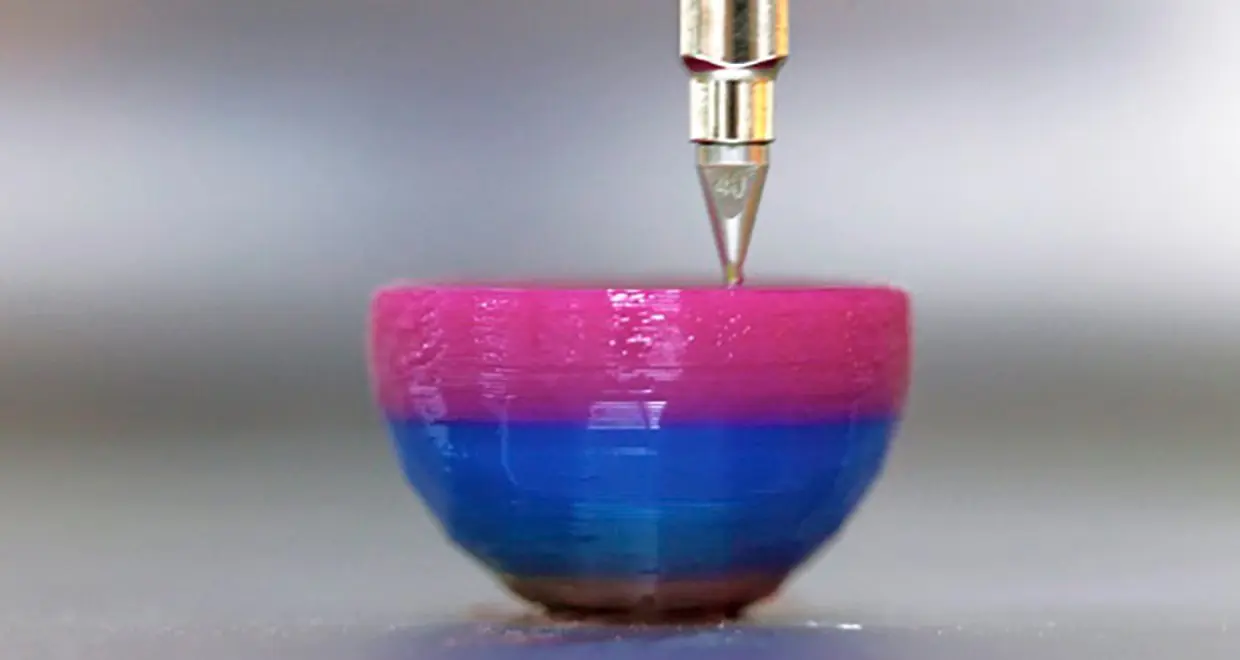
Farbiger FDM-3D-Druck (Quelle: 3Dnatives)
Abhängig davon, wie viele Filamente der Drucker gleichzeitig verarbeitet, drucken FDM-3D-Drucker in einer einzigen Farbe, die dem jeweiligen Filament entspricht, mit zwei Farben aus einer doppelten Extrusionsdüse oder in mehreren Farben und Schattierungen.
Der wesentliche Vorteil dieser mehrfarbigen 3D-Drucker liegt in ihrer einfachen Bedienung und ihrem erschwinglichen Preis. Zu den Nachteilen gehören jedoch die fehlende Möglichkeit, einen bestimmten Farbton und sichtbare Schichtlinien auf dem fertigen Teil zu erzielen. Außerdem muss man beachten, dass die Anzahl der Extrusionsdüsen eines FDM-Druckers proportional zum Risiko eines Fehldrucks steht. Je mehr Düsen, desto öfter treten Fehldrucke auf. Zudem produzieren FDM-3D-Drucker beim Tuning Materialabfälle, die sich nicht umgehen lassen.
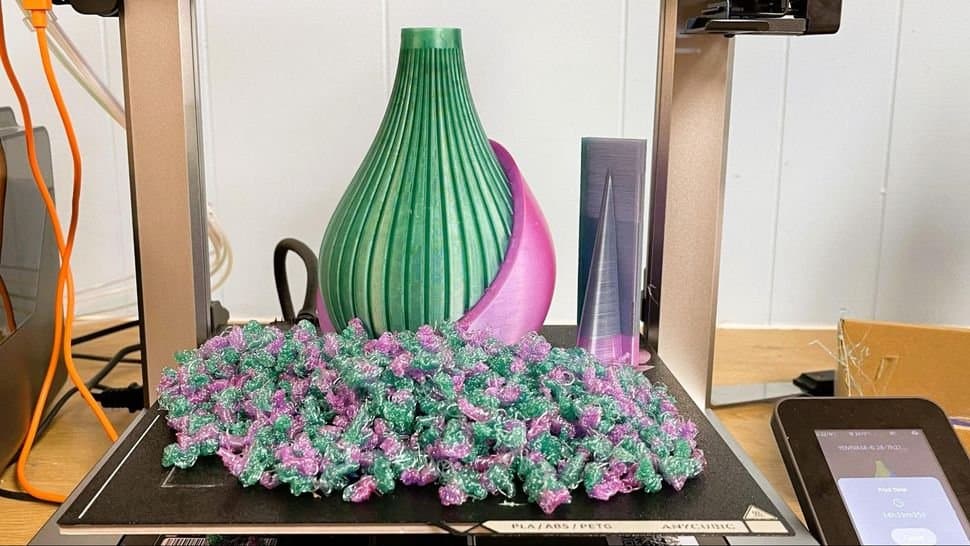
Diese 3D-gedruckte Vase erzeugt 195 g Abfall, gegenüber 185 g des für die Vase verwendeten Materials. Bildrechte: Tom's Hardware
3D-Druck mit Farbanpassung
Direkter Farb-3D-Druck ist auf die im Handel erhältlichen Farboptionen beschränkt, doch Lösungen zur Farbanpassung erlauben den 3D-Druck in fast jeder beliebigen Farbe.
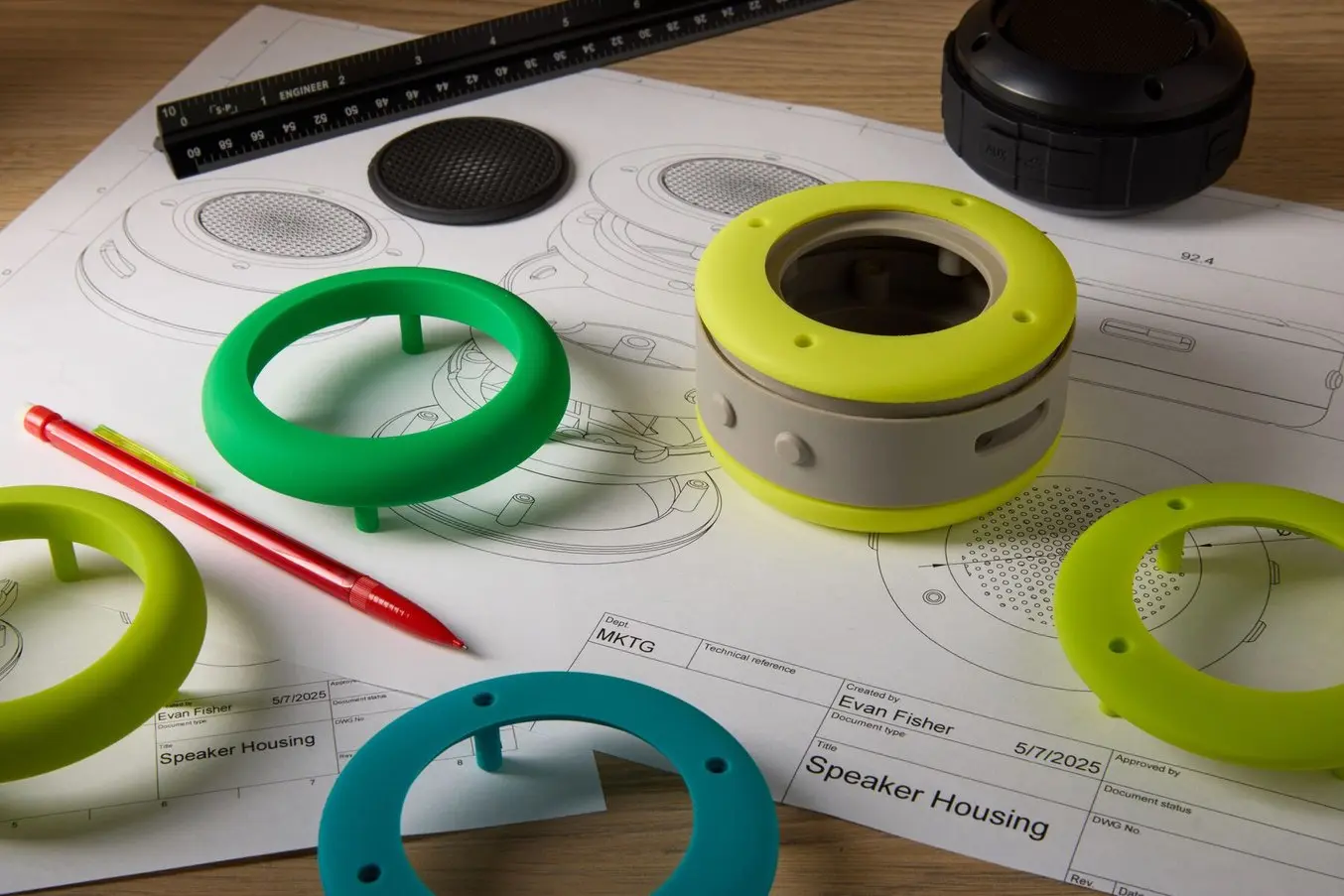
Teile gedruckt mit Form 4 und Color Resin in benutzerdefinierten Farben.
Die SLA-3D-Drucker (Stereolithografie) von Formlabs bieten mit Color Resin die Möglichkeit, farbige Teile zu drucken. Es ist eine breite Palette von klassischen Farbtönen verfügbar, für den direkten Druck von Farben wie Signalrot, Kobaltblau, Goldgelb, Royal Purple, Kelly-Grün und weiteren. Außerdem können beliebige Farben auf Bestellung gefertigt und gemischt werden, um eine individuelle Farbe zu erhalten, die zu einer Marke, einer Produktlinie oder einer kreativen Vision passt.
Beim SLA-3D-Druck wird Kunstharz Schicht für Schicht ausgehärtet. Dabei entstehen 3D-Druckteile mit glatten Oberflächen und kaum wahrnehmbaren Schichtlinien, deren Farben von nuancierten Neutraltönen bis zu satten, kräftigen Akzentfarben reichen.
Color Resin ist derzeit nur in den USA erhältlich, wird aber in naher Zukunft auch in anderen Regionen angeboten.
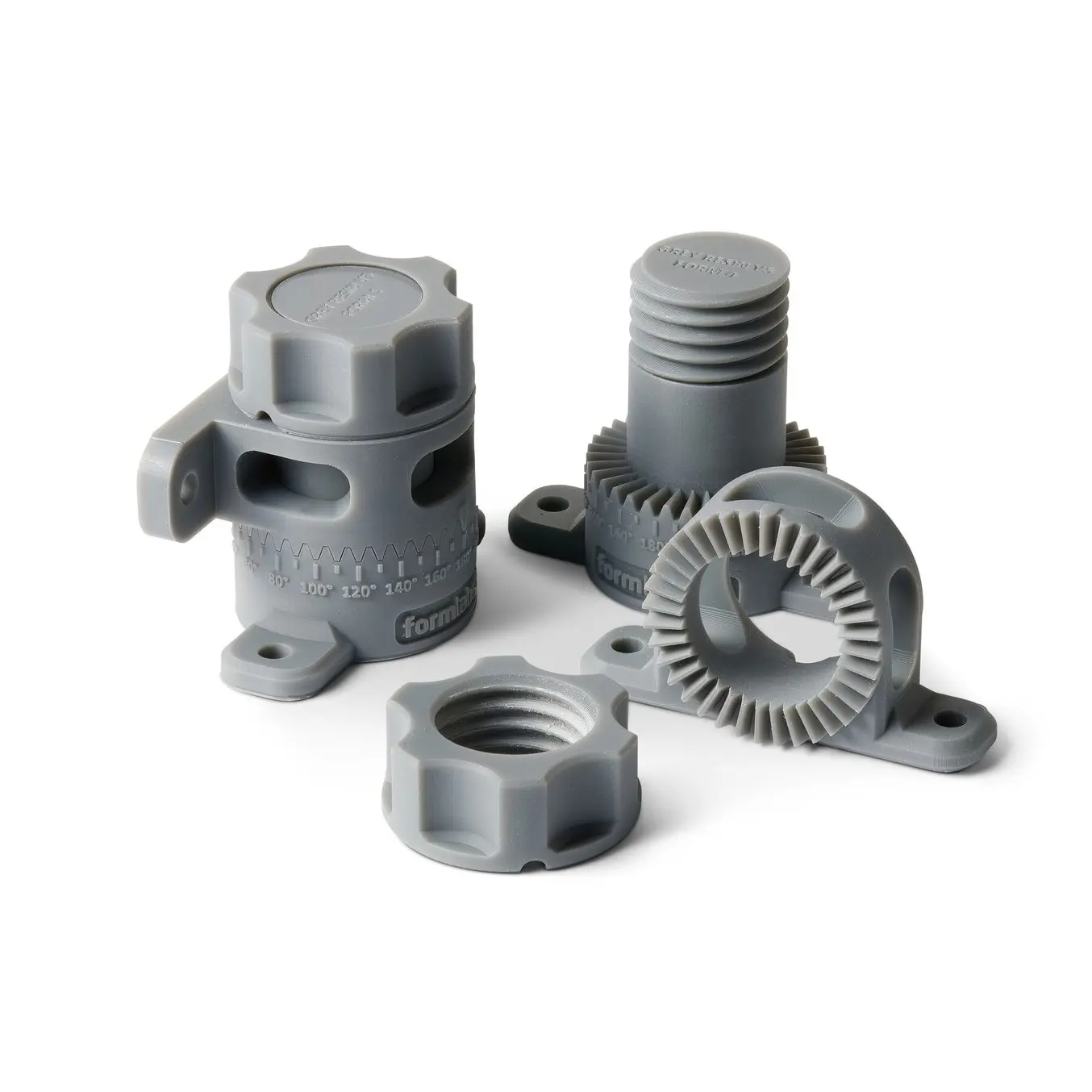
Kostenlosen Probedruck anfordern
Sehen und fühlen Sie die Qualität von Formlabs aus erster Hand. Wir senden Ihnen einen kostenlosen Probedruck an Ihren Arbeitsplatz.
Vollfarbiger 3D-Druck
Vollfarbiger 3D-Druck ist das vielseitigste Farbdruckverfahren, da es Objekte gleich in mehreren Farben erstellt. Dabei wird jeder Farbton erreicht und die Teile sind realistisch.
Im Gegensatz zu den farbigen Filamenten oder Kunstharzen nutzt vollfarbiger 3D-Druck keine vordefinierten Farben. Die Farbe wird beim Druckprozess zum Grundmaterial hinzugefügt – ähnlich, wie man es von Papierdruckern kennt.
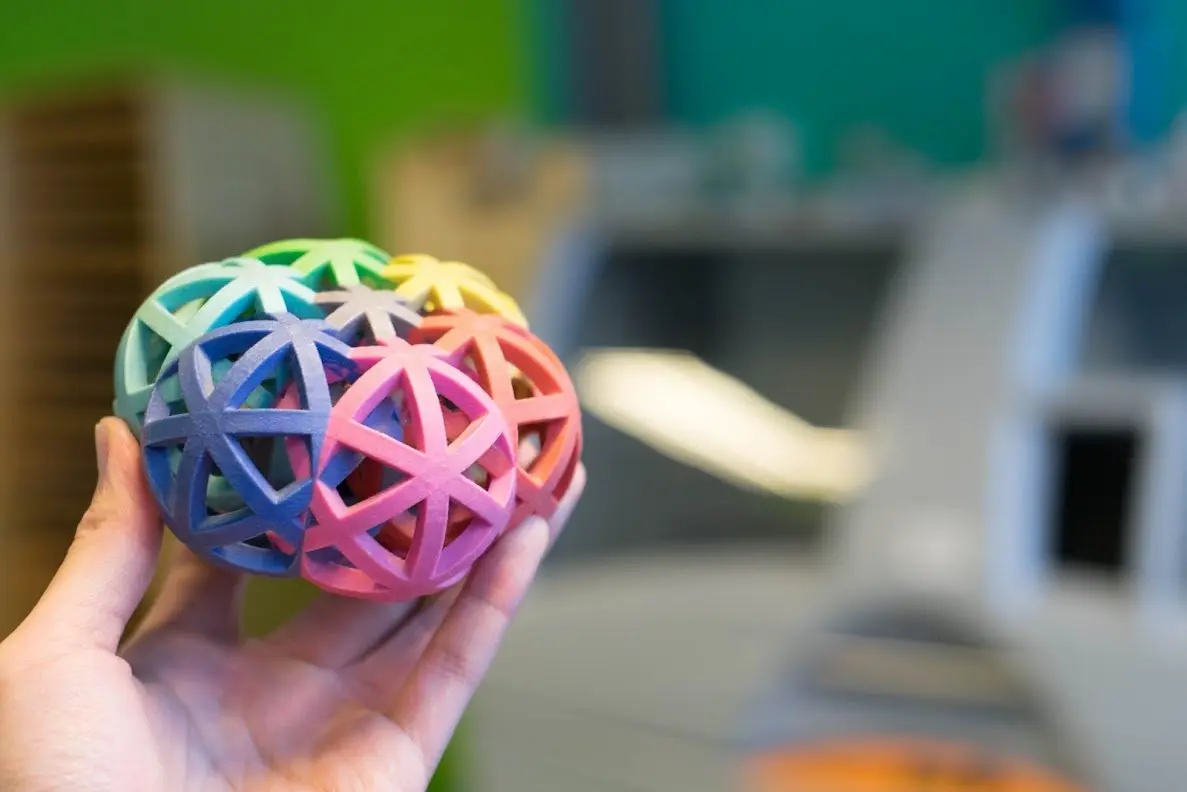
3D-Druckteile aus vollfarbigem Binder Jetting (Quelle: Hubs)
Technologien wie Binder Jetting oder Material Jetting erstellen vollfarbige 3D-Drucke. Der Nachteil ist der hohe Einstiegspreis, der es für die meisten Nutzer*innen unmöglich macht. Und nur ein einziger Hersteller bietet einen erschwinglicheren FDM-Drucker für vollfarbigen Druck an.
Lackierung 3D-gedruckter Teile
In manchen Fällen bieten 3D-Farbdrucke nicht die Detailtiefe oder die kräftigen Farben, die den Designer*innen oder Künstler*innen vorschweben. Die Lackierung monochromer 3D-Druckteile mit Acryl-, Öl- oder Sprühfarbe ist zwar zeitaufwändiger, bietet aber eine kostengünstige und vollständig anpassbare Lösung.
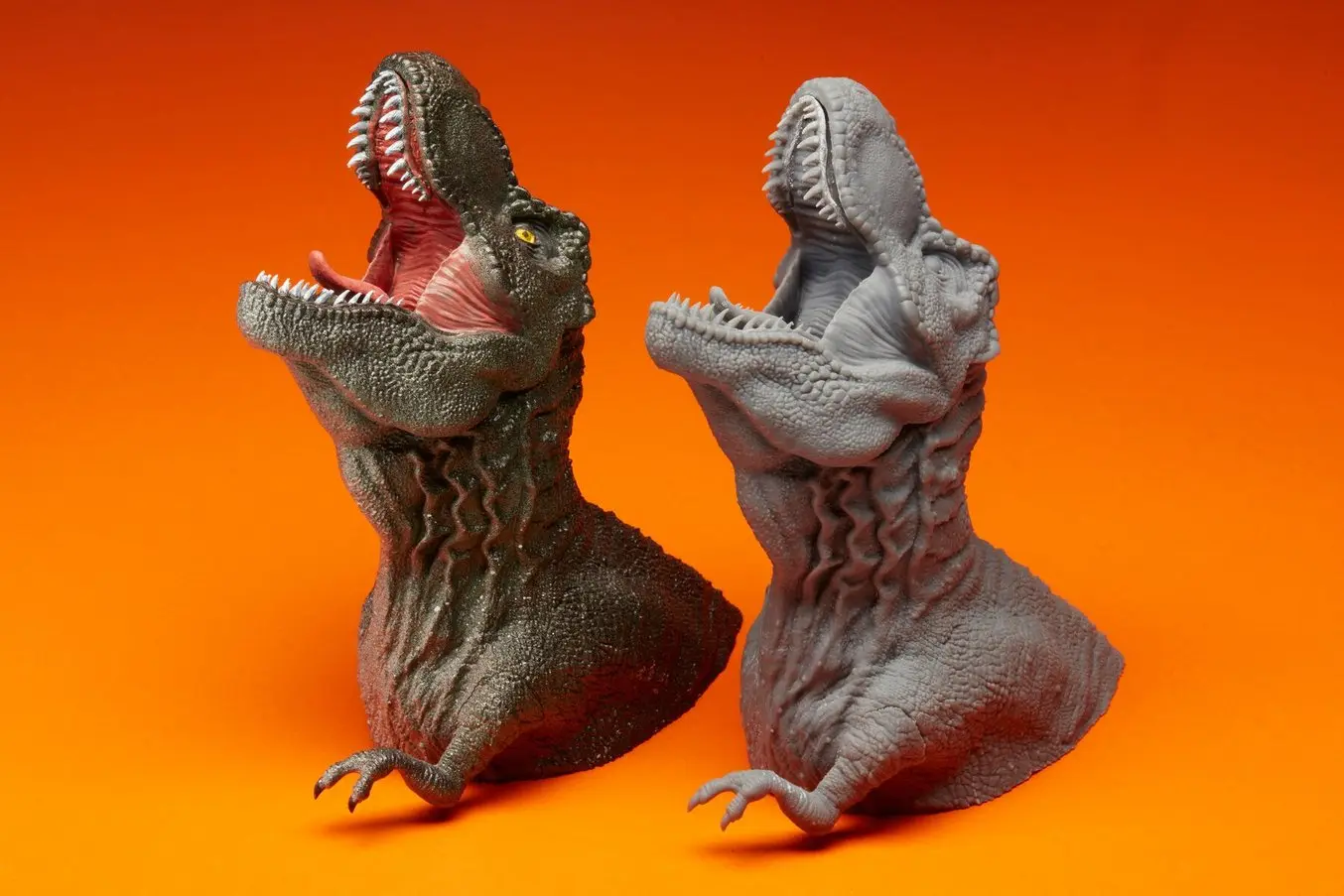
Miniatur eines Dinosauriers aus dem SLA-Drucker vor und nach dem Lackieren
Modelle, die absolut glatt sein müssen oder filigrane Details aufweisen, benötigen vor der Lackierung wahrscheinlich Nachbearbeitung wie etwa Schleifen, Grundieren oder die Anwendung eines Lösungsmittels.
Schleifen verringert die Unebenheiten auf der Oberfläche und Grundierung füllt kleine Risse und Löcher. Einige 3D-Teile bedürfen außerdem eines Voranstrichs, um die neutrale Farbe der Grundierung vor der Lackierung abzuschwächen.
Schauen oder lesen Sie unseren schrittweisen Leitfaden zur Grundierung und Lackierung 3D-gedruckter Teile.
Wassertransferdruck bei 3D-Druckteilen
Wassertransferdruck ist ein beliebtes Verfahren, um Druckdesigns auf 3-dimensionale Oberflächen zu übertragen. Bei diesem Prozess druckt ein Tintenstrahldrucker ein Bild auf einen Polyvinylalkoholfilm. Der Film wird anschließend in Wasser eingetaucht und mit einem chemischen Spray aktiviert. Der Farbfilm streckt sich dann über das langsam eingetauchte Objekt und bleibt daran kleben.
Falls Sie mehr über diesen Prozess erfahren möchten, lesen Sie unseren Leitfaden über Farbmuster, 3D-Drucke und Wassertransferdruck.
3D-Farbdruckprozesse
Zu den gängigsten Technologien für Farb-3D-Druck zählen Schmelzschichtung (FDM, von Englisch „Fused Deposition Modeling“), Stereolithografie (SLA), selektives Lasersintern (SLS), Multi Jet Fusion (MJF), Binder Jetting und Material Jetting. Werfen wir einen Blick auf die jeweiligen Vor- und Nachteile jedes Verfahrens.
FDM
FDM, von engl. Fused Deposition Modeling, zu Deutsch Schmelzschichtung, ist die am weitesten verbreitete und billigste 3D-Drucktechnologie. FDM-3D-Drucker fertigen Teile durch Schmelzen und Extrudieren eines thermoplastischen Kunststofffadens (genannt Filament), der von einer Druckdüse schichtweise auf dem Konstruktionsbereich aufgetragen wird.
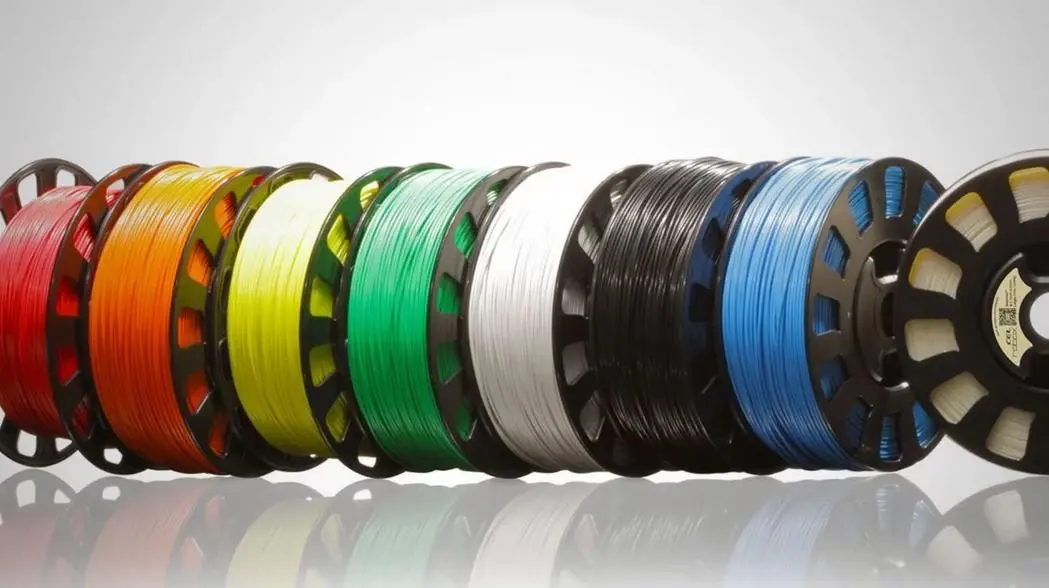
Filamente in verschiedenen Farben für den FDM-Druck (Quelle: All3DP.com)
FDM wird häufig für den direkten Farbdruck eingesetzt, entweder mit einer einzigen Extrusionsdüse oder mit mehreren Extrusionsdüsen für den Druck in mehreren Farben.
Der erste Vollfarb-FDM-Drucker war der 3D-Drucker da Vinci Color, der ein farbloses Filament mit einem CMYK-Tintenstrahl einfärbt, bevor es extrudiert wird, ähnlich wie bei einem Papierdrucker.
SLA
SLA-Druck oder Stereolithografie nutzt einen Laser, der flüssiges Kunstharz zu gehärtetem Kunststoff aushärtet. Dieser Prozess wird als Photopolymerisation bezeichnet. SLA-Teile bieten die höchste Auflösung und Präzision, die filigransten Details und die glattesten Oberflächen aller 3D-Drucktechnologien für Kunststoffe.
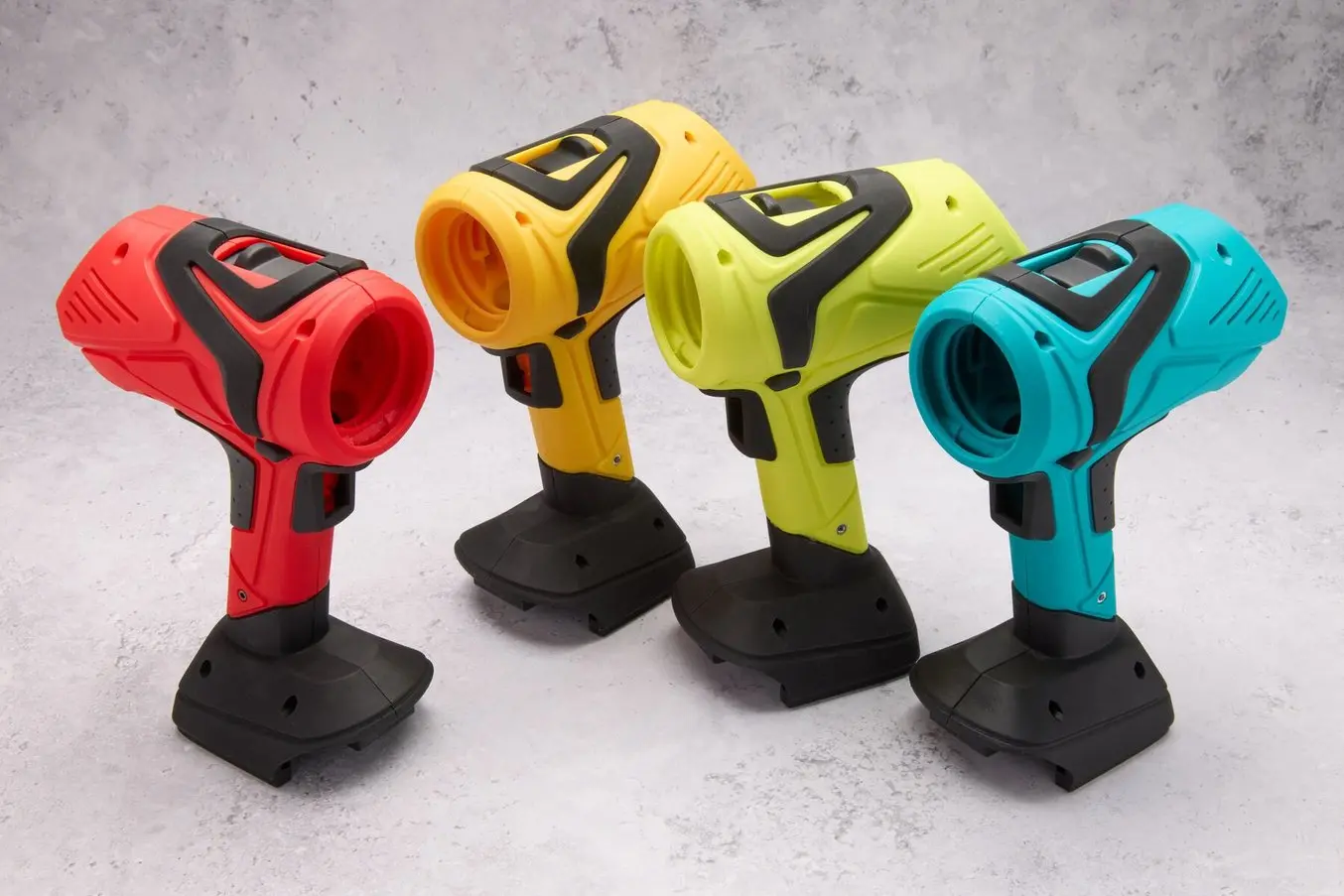
Farbige SLA-Teile, 3D-gedruckt mit Color Resin auf dem Form 4.
SLA erlaubt es, fast jeden beliebigen Farbton abzubilden oder Teile in klassischen Farben zu drucken, dank Color Resin, der ersten Materiallösung für den SLA-3D-Druck in einer benutzerdefinierten Farbe. Und dank ihrer glatten Oberfläche lassen sich SLA-Drucke außerdem leicht nachbearbeiten, lackieren oder beim Wassertransferdruck einsetzen.
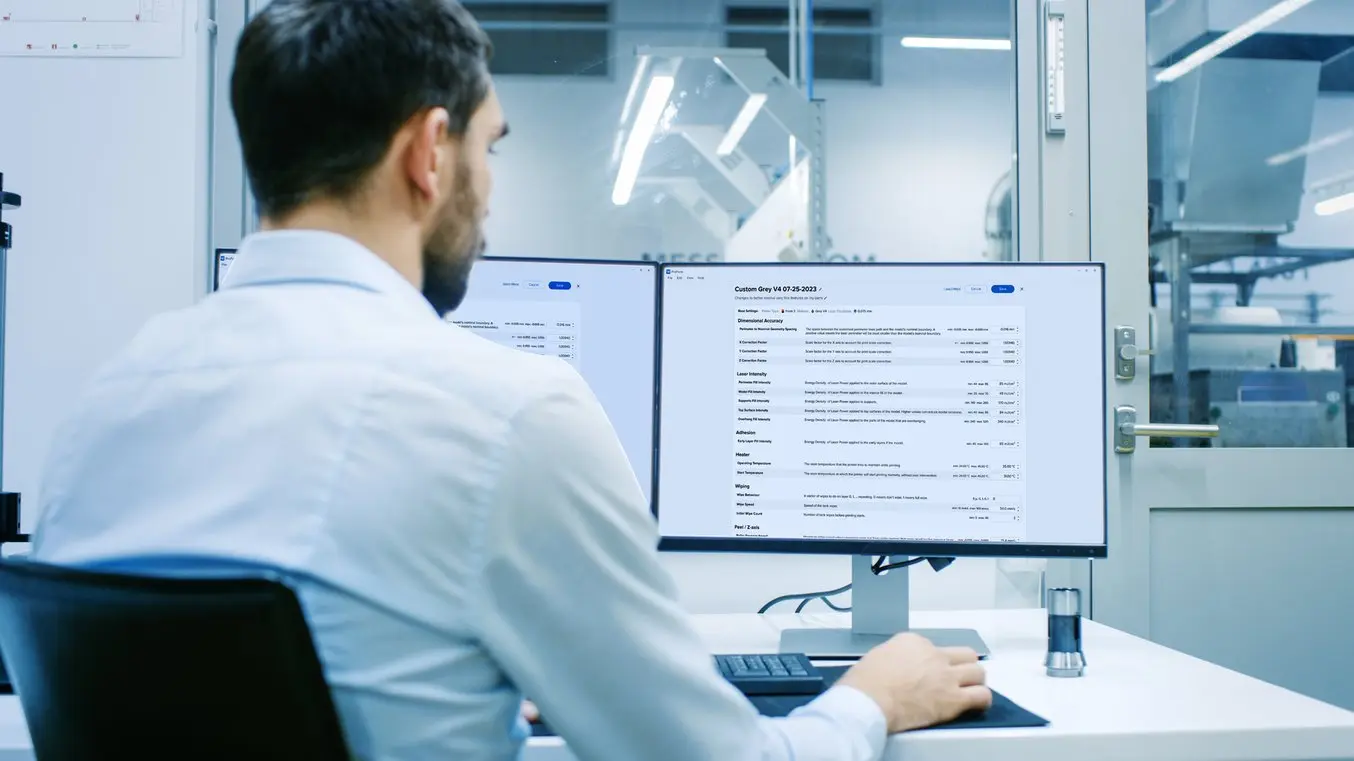
Kontaktieren Sie unser Vertriebsteam
Ganz gleich, ob Sie schnelle Prototypen herstellen oder fertige Teile für die Endverwendung produzieren, wir stehen Ihnen mit Rat und Tat zur Seite. Das Formlabs-Vertriebsteam besteht aus engagierten Fachleuten, die Sie und Ihr Unternehmen bei Bedarf mit professioneller Hilfe unterstützen.
SLS
Selektives Lasersintern (SLS) ist die am häufigsten genutzte Technologie der additiven Fertigung bei industriellen Anwendungen. Ingenieur*innen und Hersteller verschiedener Branchen setzen auf SLS, um starke und funktionsfähige Teile zu produzieren.
SLS-3D-Drucker nutzen als Rohmaterial weißes, graues oder schwarzes Nylonpulver. Die Teile lassen sich zwar nicht direkt in Farbe drucken, jedoch können sie im Nachhinein eingefärbt oder lackiert werden. Es gibt vier Färbemethoden, die je nach Arbeitsablauf und Budget unterschiedliche Vor- und Nachteile haben.
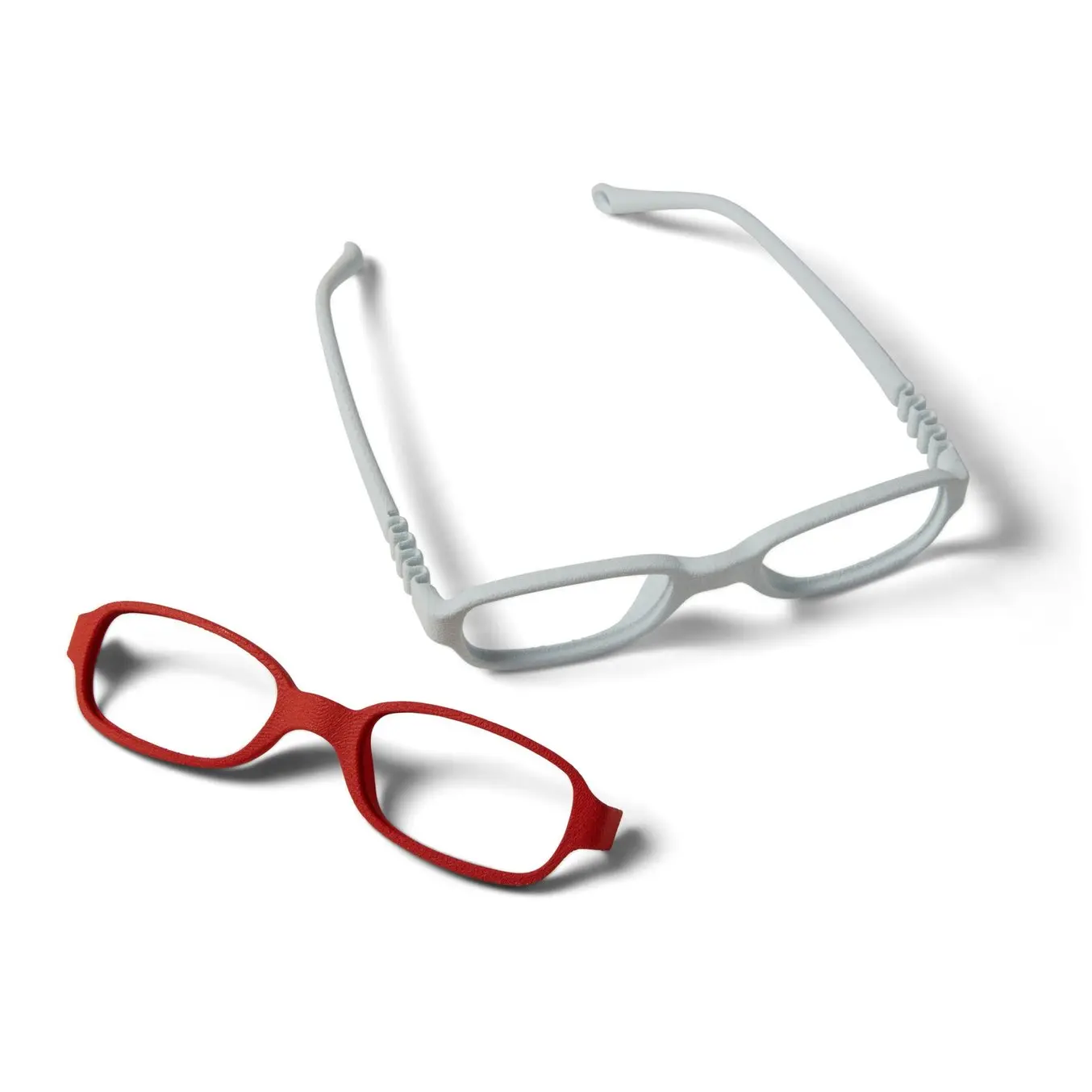
Färben von SLS-3D-gedruckten Teilen: Vorteile und Arbeitsablauf
In diesem Whitepaper betrachten wir die Erwägungen, Vorteile, Nachteile und verfügbaren Methoden zum Färben von SLS-Teilen. Weiterhin bieten wir eine Schritt-für-Schritt-Anleitung einschließlich Vorbereitungstechniken und Optionen zur Fertigstellung nach dem Färben.
Binder Jetting
Binder Jetting ist ein dem SLS- und MJF-Druck ähnliches 3D-Druckverfahren, jedoch mit dem Unterschied, dass hier anstelle von Hitze ein farbiges Bindemittel pulverförmiges Sandsteinmaterial verbindet.
Teile, die mit Binder Jetting gefertigt wurden, haben eine poröse Oberfläche und sind sehr spröde, weshalb dieses Verfahren nur für statische Anwendungen empfohlen wird, z. B. für vollfarbige Figuren und Konzeptmodelle.
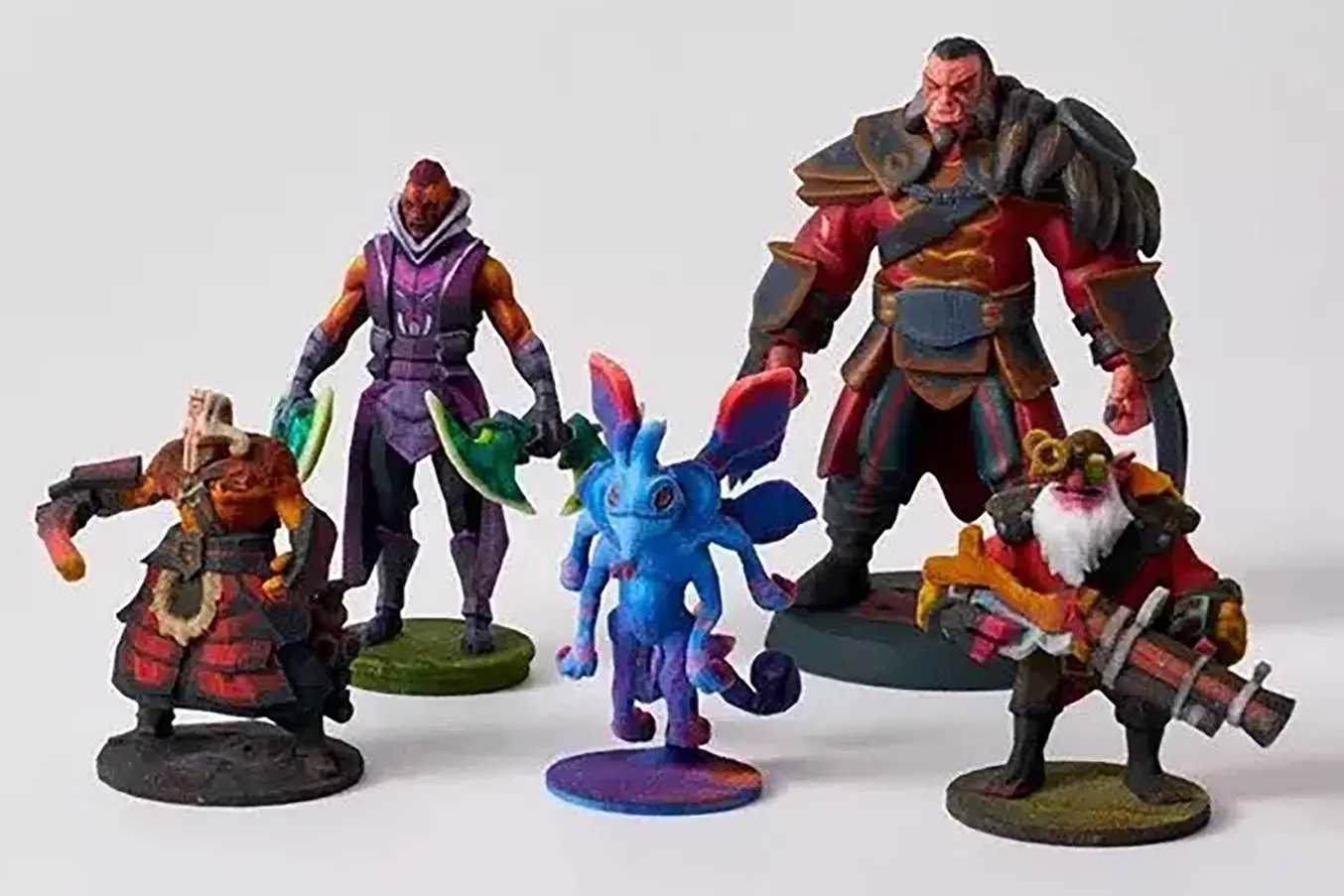
Via Binder Jetting gedruckte Figuren (Quelle: Shapeways)
Material Jetting
Material-Jetting- und PolyJet-3D-Drucker kombinieren traditionelle Tintenstrahldrucker mit Photopolymer-Kunstharzen. Tröpfchen des Materials werden auf einer Konstruktionsfläche abgelagert, wie bei einem Papierdrucker, und dann mit UV-Licht ausgehärtet.
Diese Verfahren bieten eine Vielzahl von Farbmöglichkeiten und können fotorealistische Teile mit leuchtenden Farben erstellen. Die Teile haben jedoch mangelhafte mechanische Eigenschaften, sind anfällig für Hitze und der Einstiegspreis ist der höchste aller farbigen 3D-Drucktechnologien.
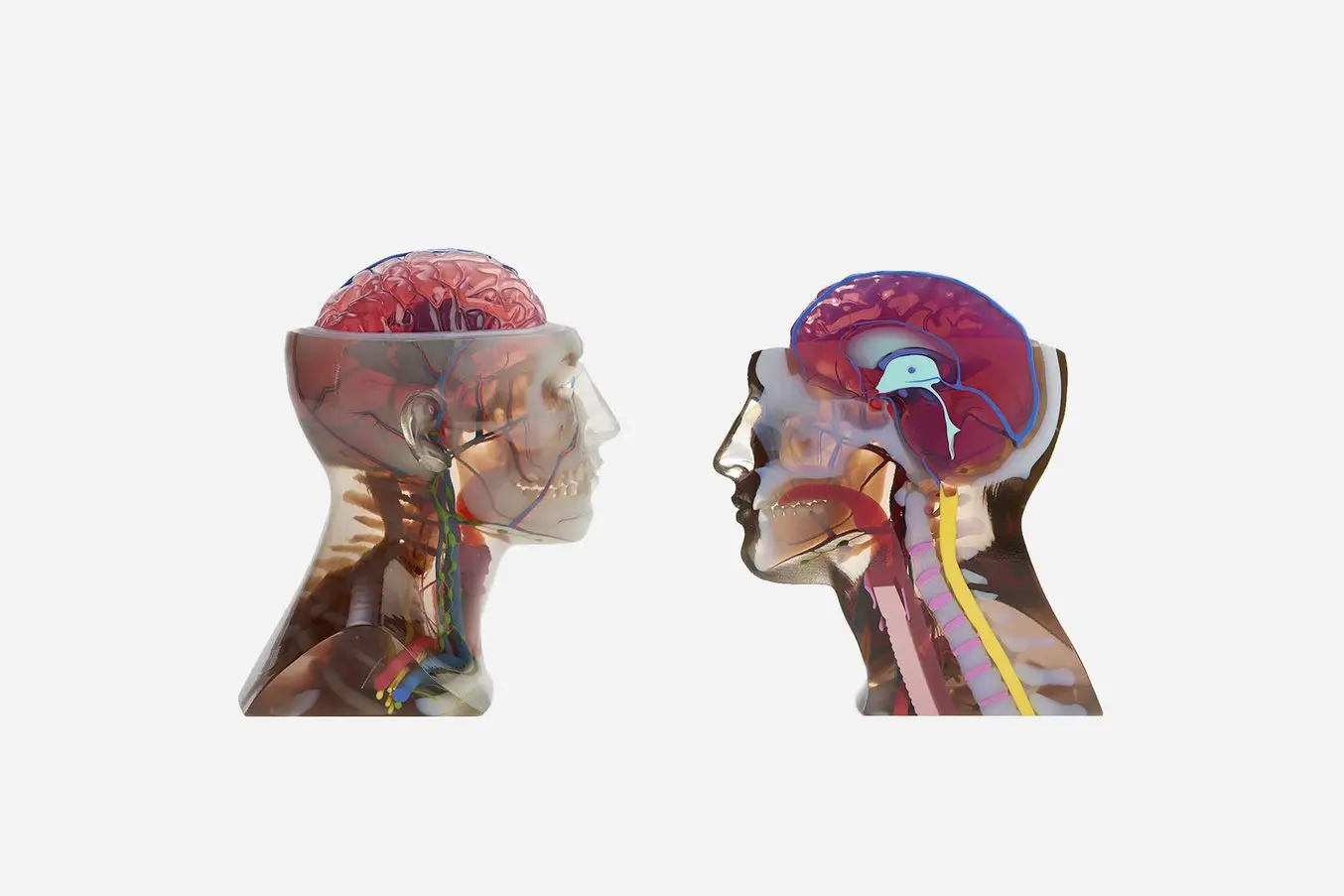
3D-Farbdrucke via Material Jetting (Quelle: Hubs)
3D-Farbdruckprozesse im Vergleich
| FDM | SLA | SLS | Binder Jetting | Material Jetting | |
|---|---|---|---|---|---|
| Auflösung | ★★☆☆☆ | ★★★★★ | ★★★★☆ | ★★★☆☆ | ★★★★★ |
| Genauigkeit | ★★★★☆ | ★★★★★ | ★★★★★ | ★★★☆☆ | ★★★★★ |
| Oberflächengüte | ★★☆☆☆ | ★★★★★ | ★★★★☆ | ★★★☆☆ | ★★★★★ |
| Benutzerfreundlichkeit | ★★★★★ | ★★★★★ | ★★★★☆ | ★★★★☆ | ★★★★☆ |
| Komplexe Designs | ★★★☆☆ | ★★★★☆ | ★★★★★ | ★★★☆☆ | ★★★★☆ |
| Beschreibung | Der Druckkopf schmilzt und extrudiert Thermoplast-Filamente. | Eine Lichtquelle härtet flüssiges Kunstharz aus. | Ein Laser oder eine andere Lichtquelle sintert Nylonpulver. | Ein Bindemittel klebt Sandsteinpartikel zusammen. | Ein Druckkopf mit Ähnlichkeit zu einem Tintenstrahldrucker härtet Kunstharztröpfchen aus. |
| Materialien | Thermoplast-Filamente | Verschiedenste flüssige Kunstharze | Verschiedene Polymerpulver | Sandstein | Verschiedenste flüssige Kunstharze |
| Optionen für 3D-Farbdruck | Direkter Farbdruck, Farbmischung oder Vollfarbe | Farbanpassung | Keine | Vollfarbe | Vollfarbe |
| Nachbearbeitung mit Farben und Lacken | Lackierung (benötigt intensive Nachbearbeitung) Wassertransferdruck | Lackierung Wassertransferdruck | Färbung Lackierung Wassertransferdruck | Lackierung Wassertransferdruck | Lackierung Wassertransferdruck |
| Anwendungen | Einfacher Modellbau | Rapid Prototyping, Teile für die Endverwendung, Miniaturen und Modelle, medizinische Modelle | Rapid Prototyping, Endverbrauchsteile | Miniaturen und Modelle | Rapid Prototyping, Miniaturen und Modelle, medizinische Modelle |
| Preis | Preiswerte FDM-Drucker und 3D-Drucker-Kits beginnen bei ca. 200 €. Professionelle Desktop-FDM-Drucker liegen zwischen 2000 € und 8000 € und industrielle Systeme sind ab 15 000 € erhältlich. | Kostengünstige Kunstharz-3D-Drucker sind für 200 € bis 1000 € erhältlich, professionelle SLA-3D-Drucker liegen im Bereich von 2500 € bis 10 000 € und großformatige Kunstharz-3D-Drucker im Bereich von 5000 € bis 25 000 €. | Industrielle SLS-3D-Drucker im Benchtop-Format beginnen bei unter 30 000 € für den Drucker und 60 000 € für das komplette Ecosystem, einschließlich Pulververwaltungs- und Reinigungsstationen. Konventionelle industrielle SLS-Drucker beginnen bei etwa 200 000 €. | Vollfarbige 3D-Drucker beginnen bei 60 000 €. | Vollfarbige 3D-Drucker beginnen bei 50 000 € und große Geräte gibt es ab 100 000 €. |
Anwendungen farbigen 3D-Drucks
Durch farbigen 3D-Druck sparen Ingenieur- und Designteams Zeit und Geld bei ihren visuellen Prototypen und sogar Endbauteilen. Bei Film und Fernsehen werden so aus digitalen Modellen Requisiten, im Modellbau entstehen lebendige Miniaturen, und in der Medizin schafft man damit präzise Anatomiemodelle und mehr.
Prototypenentwicklung
Rapid Prototyping ermöglicht es Unternehmen, Ideen in realistische Konzeptnachweise zu verwandeln, diese Konzepte zu Prototypen mit hoher Originaltreue weiterzuentwickeln, die wie Endprodukte aussehen und funktionieren, und Produkte durch eine Reihe von Validierungsphasen zur Massenproduktion zu führen.
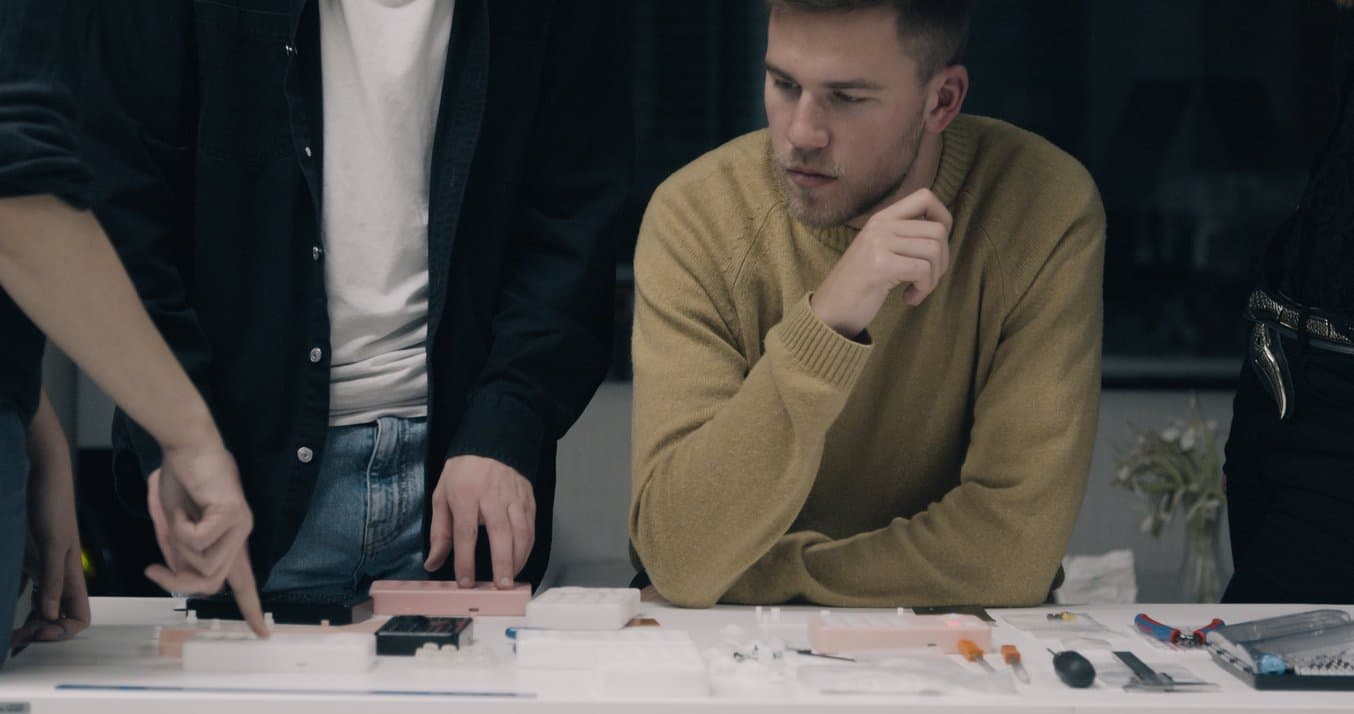
Das Entwicklerteam von birdkids fertigte mit SLA-Druck farbige Prototypen.
Konzeptmodelle dienen zur Präsentation einer Idee, bieten Diskussionsstoff und beschleunigen als risikoarme Konzeptbeispiele Akzeptanz oder Ablehnung.
Im fortschreitenden Prozess gewähren Anschauungsprototypen in Farbe ein besseres Verständnis, wie das Endprodukt aussehen wird und wie die Endnutzer*innen damit umgehen. Die Ergonomie, die Benutzeroberfläche sowie die allgemeine Benutzererfahrung können mit 3D-gedruckten Prototypen validiert werden, bevor wesentliche Investitionen in Design und technische Umsetzung der endgültigen Produktmerkmale getätigt werden.
Drucke mit Farbanpassung oder in Vollfarbe lassen Produktentwicklerteams auch mit verschiedenen Farben experimentieren und die Kund*innen dazu befragen, bevor man zur Produktion übergeht.
Unterhaltungsindustrie
In der Unterhaltungsindustrie schlagen 3D-gedruckte Requisiten und Modelle die Brücke zwischen praktischen Modellen und digitalen Effekten. Die Künstler*innen erstellen realistische und detailreiche Modelle in ihrer 3D-Software und hauchen diesen dann in wenigen Stunden mit dem 3D-Drucker Leben ein. Hochauflösende 3D-Druckprozesse wie SLA bilden auch die kompliziertesten Parameter des Designs ab, z. B. Hauttexturen.
So setzten etwa Requisiteure wie Russell Bobbitt für Marvel-Kinoumsetzungen und Jaco Snyman bei der Serie „Raised by Wolves“ oder auch das Visual-Effects- und Designstudio Aaron Sims Creative bei der Serie „Stranger Things“ auf die Technologie, da sie den Bau von Requisiten nicht nur erheblich beschleunigt, sondern auch die Kreativität in ihrer Gestaltung fördert. Der Designprozess wird durch sie flexibler und plastischer, die Herstellung der Requisiten und Modelle zudem deutlich effizienter.
Miniaturen und Modelle
Zweifelsohne hat 3D-Druck die Erstellung von Miniaturen und Figuren revolutioniert, ob für den Modellbau, Brettspiele, Sammlerstücke oder für sonstige Hobbys.
Vollfarbige 3D-Drucker übersteigen oft das Budget von Hobbybastler*innen und Modellbauer*innen. Bei ihnen ist Handbemalung traditionellerweise ohnehin die beliebteste Methode und dies lässt sich wunderbar nach dem 3D-Druck umsetzen.
Beispielsweise kombinieren die Künstler*innen bei Modern Life Workshop 3D-Modelldesign mit SLA-3D-Druck, um realistische Portraits von Prominenten zu erstellen. Die Künstler*innen verwenden die digitale Freihandskulptur-Software ZBrush, um detaillierte Modelle am Computer zu erstellen. Danach drucken sie die Designs auf einem SLA-Drucker und bemalen sie von Hand.
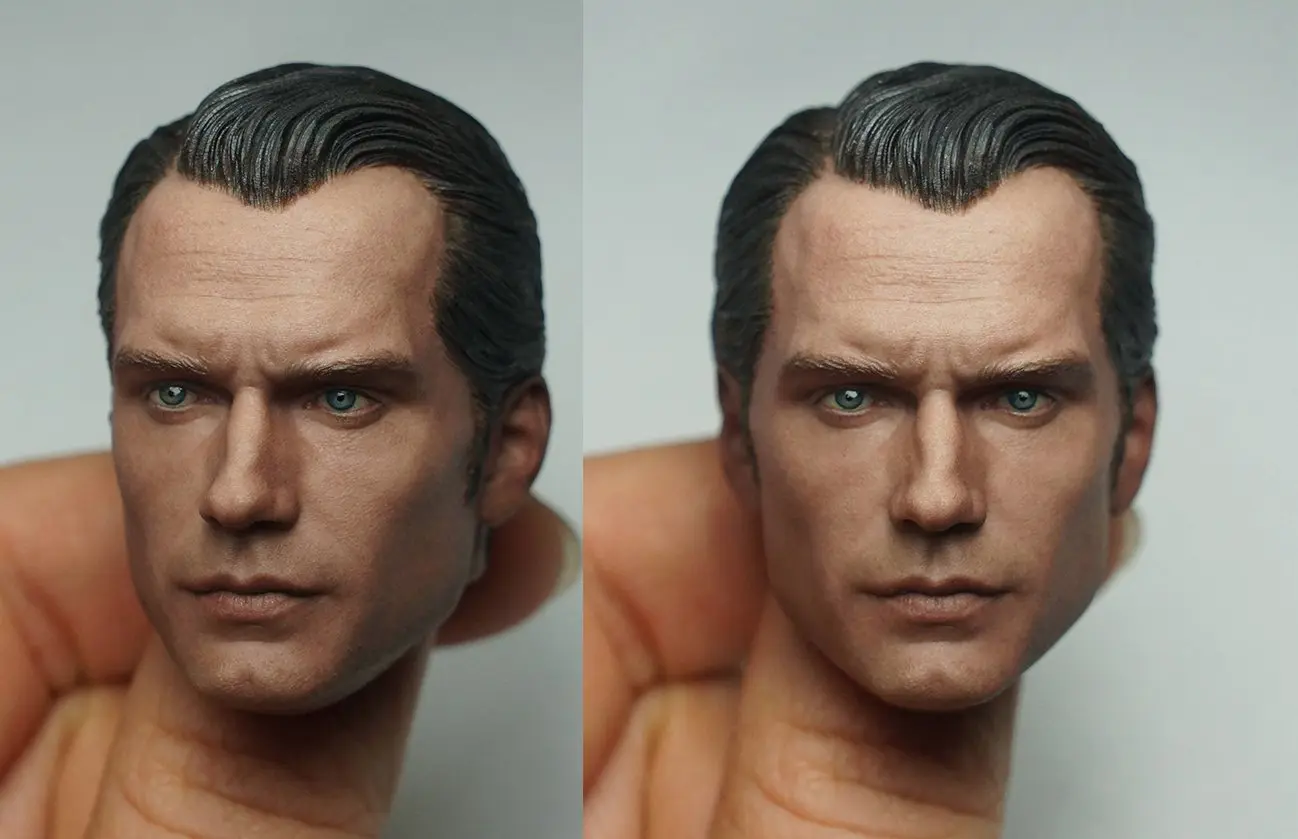
Das Künstlerteam des Modern Life Workshop kreiert gestützt auf ZBrush und 3D-Drucker hyperrealistische Skulpturen.
Eine Bereicherung ist der 3D-Druck auch für das Gaming-Universum. Hier sind inzwischen ganze Online-Communitys entstanden, in denen die Mitglieder für Pen-&-Paper-Spiele wie etwa Dungeons & Dragons einzigartige Kreationen von Miniaturen und Figuren, Terrains, Landschaften und anderem Spielezubehör aus dem 3D-Drucker präsentieren.
Professionelle Modellbauunternehmen wie DM-Toys nutzen ebenfalls 3D-Druck, um die Prototypenfertigung und die Produktion maßgeschneiderter Modelle zu beschleunigen.
Das weltweit bekannte Spiele- und Unterhaltungsunternehmen Hasbro verwendete 3D-Druck in seinem bahnbrechenden Projekt Hasbro Selfie Series zur Massenproduktion individualisierter Actionfiguren. Die Selfie Series lieferte Fans personalisierte, nach ihrem Ebenbild designte Actionfiguren direkt an die Haustür, auf Grundlage eines Gesichtsscans mit dem Smartphone.
Medizinische Modelle und Prothetik
Im Gesundheitswesen wenden sich immer mehr Personal aus Radiologie, Chirurgie und Biomedizin dem 3D-Druck zu, um präzise Anatomiemodelle zu erstellen, welche dann als Referenz dienen, für die Operationsplanung, für die Visualisierung während der OP oder auch zur Ausbildung.
Mit 3D-druck erstellen Mediziner*innen komplexe Modelle mit filigranen Details, die mit anderen Technologien unmöglich währen.
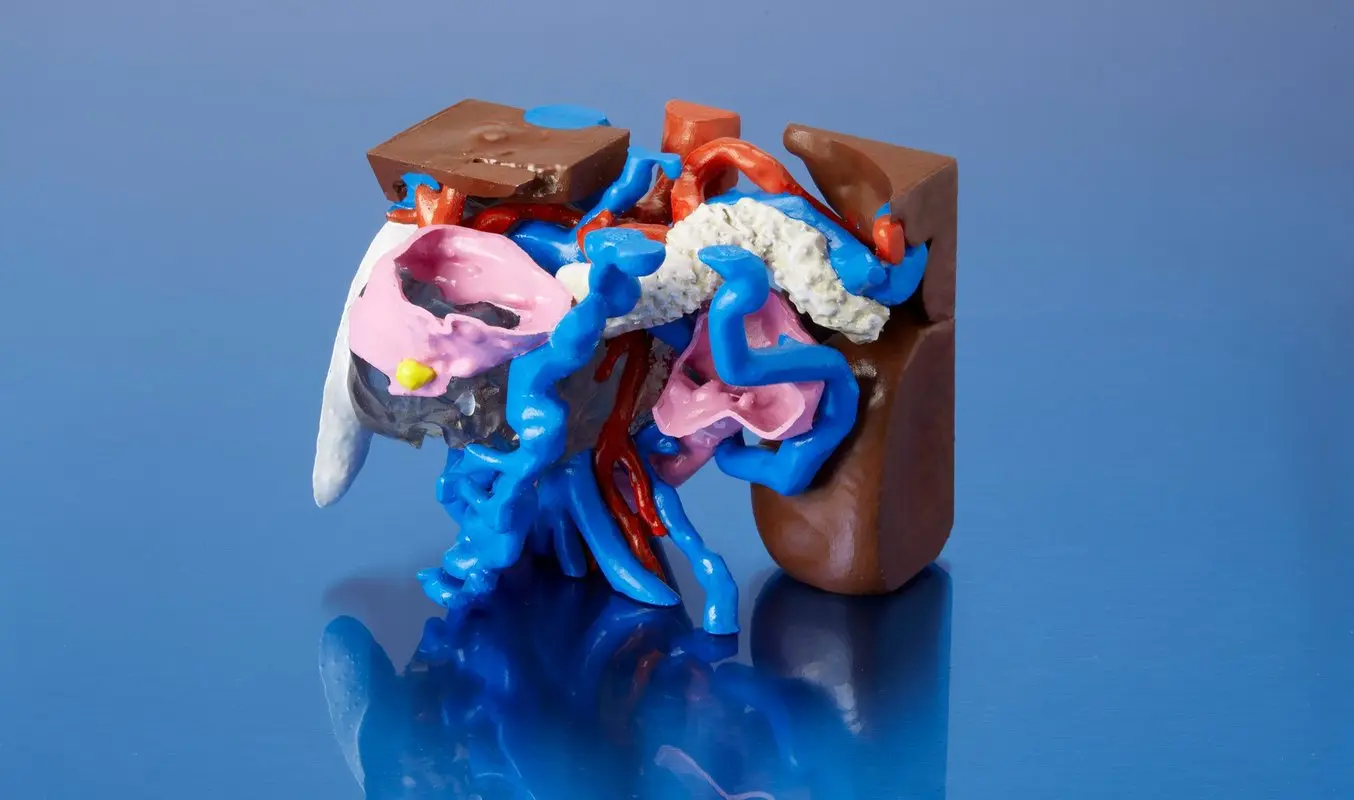
Ein farbiges Modell einer Bauchspeicheldrüse, das auf einem SLA-Drucker gedruckt und anschließend mit Acrylfarben bemalt wurde.
Hochdetaillierte Farbmodelle eigenen sich hervorragend zur Ausbildung von Assistenzärzt*innen, da man jedes Blutgefäß oder Organ zu Anschauungszwecken 3D-drucken und mit einer anderen Farbe versehen kann.
Außerdem werden Anatomiemodelle aus Scandaten der Patient*innen in der heutigen patientenspezifischen Präzisionsmedizin immer nützlicher.
Der 3D-Druck ermöglicht die Herstellung maßgefertigter Prothesen, die auf optimalen Patientenkomfort zugeschnitten sind. Nach dem Druck werden die Prothesen mit biokompatiblen Lacken lackiert oder nach dem Lackieren mit einer biokompatiblen Versiegelung überzogen, um sie hautverträglich zu machen.
Dr. Travis Bellicchi druckte für die krebskranke Shirley Anderson eine Kieferprothese mit einem Verfahren, das nach der Patientin benannt wurde: der Shirley-Technik. Auf der anderen Seite der Welt erstellten Ärzte in Singapur eine Nasenprothese für den Hautkrebspatienten J.F. Lian, wofür mehrere 3D-Drucke lackiert wurden, um sie an Lians Hautton anzupassen.
Farbe in den 3D-Druck bringen
Mit Techniken vom direkten Druck in einer Wunschfarbe oder mehreren Farben bis hin zum Färben, Lackieren und der Hydrographie gibt es zahlreiche Möglichkeiten, farbige 3D-Druckteile mit einer Reihe mechanischer Eigenschaften zu liefern.
Kunstharz-3D-Drucker bieten glatte Oberflächen, die sich zum Lackieren oder für die Hydrographie eignen, und mit den Kunstharz-Druckern von Formlabs können Teile auch direkt in benutzerdefinierten Farben gedruckt werden. SLS-Teile hingegen lassen sich einfärben – von vollen, einheitlichen Farben bis hin zu Farbübergängen und Effekten.
Entdecken Sie Formlabs' 3D-Drucker, um selbst in den Druck einzusteigen, oder kontaktieren Sie den Vertrieb, um weitere Informationen zu erhalten.
Sie sind nicht sicher, welche 3D-Druck-Lösung die beste für Ihr Unternehmen ist? Buchen Sie eine persönliche Beratung, um Optionen zu vergleichen, die Kapitalrendite zu bewerten, Testdrucke zu begutachten und vieles mehr.
